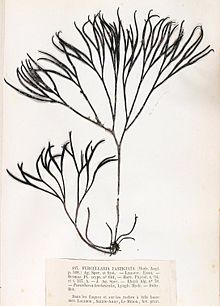Furcellaran
Furcellaran is a polysaccharide of the red alga Furcellaria lumbricalis ( Hudson ) JV Lamouroux 1813, which was formerly also called F. fastigiata . It is often referred to as Danish agar or Baltic agar and is structurally very similar to carrageenan , which is also used as a food additive E 407. Furcellaran is used, among other things, to make puddings , cake toppings and pie fillings . It also facilitates protein separation and thus the final filtration in beer production .

Furcellaran consists of chains in which D-galactopyranoside (46–53%) and 3,6-anhydrogalactose units (30–33%) alternate, both of which contain sulfate residues . While the ratio of sulfate residues to sugar building blocks is around 1: 2 in carrageenan, it is on average 1: 3 to 1: 4 in furcellaran. In order to increase the gel strength, sugar is usually added. The CAS number of furcellaran is 9000-21-9.
Manufacturing
The alga F. lumbricalis is a North Atlantic species and is often harvested in Denmark (also in the Baltic Sea) and Canada ( Prince Edward Island ). To produce furcellaran, the algae are pretreated in an alkaline solution and then extracted with water. It is then concentrated in vacuo and gelled using potassium chloride . Finally, the gel threads are concentrated by freezing them out.
Individual evidence
- ↑ a b Furcellaria lumbricalis on Seaweadindustry.com (accessed April 26, 2018).
- ↑ a b c d e entry on furcellaran. In: Römpp Online . Georg Thieme Verlag, accessed on June 4, 2020.
- ↑ A red seaweed ( Furcellaria lumbricalis ) in The Marine Life Information Network (accessed on 27 April 2018).